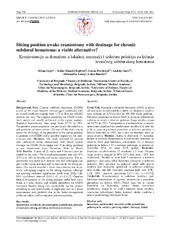Приказ основних података о документу
Sitting position awake craniostomy with drainage for chronic subdural hematoma: a viable alternative?
| dc.creator | Lepic, Milan | |
| dc.creator | Mandic-Rajcevic, Stefan | |
| dc.creator | Pavlicevic, Goran | |
| dc.creator | Savic, Andrija | |
| dc.creator | Lokaj, Aleksandra | |
| dc.creator | Rasulic, Lukas | |
| dc.date.accessioned | 2022-03-04T11:24:53Z | |
| dc.date.available | 2022-03-04T11:24:53Z | |
| dc.date.issued | 2021 | |
| dc.identifier.issn | 0042-8450 | |
| dc.identifier.uri | http://TechnoRep.tmf.bg.ac.rs/handle/123456789/4932 | |
| dc.description.abstract | Background/Aim. Chronic subdural hematoma (CSDH) is one of the most frequent neurosurgical conditions with an overall incidence ranging from 1.72 to 20.6 per 100,000 persons per year. The surgical procedure for CSDH is relatively simple and usually performed in the supine position. Reported reoccurrence rates range from 11.7% to 28%. Postperative pneumocephalus was previously identified as a sole predictor of reoccurrence. The aim of this study was to assess the advantage of the procedure in the sitting position in patients with CSDH and a possible impact on the reoccurrence rate. Methods. The study included 31 patients who underwent awake craniostomy with closed system drainage for CSDH (16 in supine and 15 in sitting position) in our department from December 2016 to March 2018. Results. A total of 22 males and 9 females were included in the study. The overall reoccurrence rate was 19% (22% and 18% in females and males, respectively). The reoccurrence was noted in 5 patients who had undergone surgery in the supine position, and in one case in the sitting position. Our results revealed a lower reoccurrence rate in patients undergoing surgery in the sitting position, although not reaching statistical significance [ odds ratio (OR): 0.18, 95% confidence interval: 0.01-1.42, p = 0.172]. Conclusion. Craniostomy in the sitting position under local anesthesia is a safe, simple, and reliable procedure for CSDH treatment. Besides being very comfortable for the patient, according to our initial results, it might also lead to a lower reoccurrence rate, probably due to the better management of the air inflow, and consequent pneumocephalus. | en |
| dc.relation | info:eu-repo/grantAgreement/MESTD/Technological Development (TD or TR)/37001/RS// | |
| dc.rights | openAccess | |
| dc.rights.uri | https://creativecommons.org/licenses/by-sa/4.0/ | |
| dc.source | Vojnosanitetski Pregled | |
| dc.subject | hematoma | en |
| dc.subject | subdural | en |
| dc.subject | neurosurgical procedures | en |
| dc.subject | posture | en |
| dc.subject | recurrence | en |
| dc.subject | sitting position | en |
| dc.subject | treatment outcome | en |
| dc.title | Sitting position awake craniostomy with drainage for chronic subdural hematoma: a viable alternative? | en |
| dc.type | article | |
| dc.rights.license | BY-SA | |
| dc.citation.epage | 562 | |
| dc.citation.issue | 5 | |
| dc.citation.other | 78(5): 556-562 | |
| dc.citation.rank | M23 | |
| dc.citation.spage | 556 | |
| dc.citation.volume | 78 | |
| dc.identifier.doi | 10.2298/VSP190611093L | |
| dc.identifier.fulltext | http://TechnoRep.tmf.bg.ac.rs/bitstream/id/7634/Sitting_position_awake_pub_2021.pdf | |
| dc.identifier.scopus | 2-s2.0-85107717630 | |
| dc.identifier.wos | 000657120900010 | |
| dc.type.version | publishedVersion |

